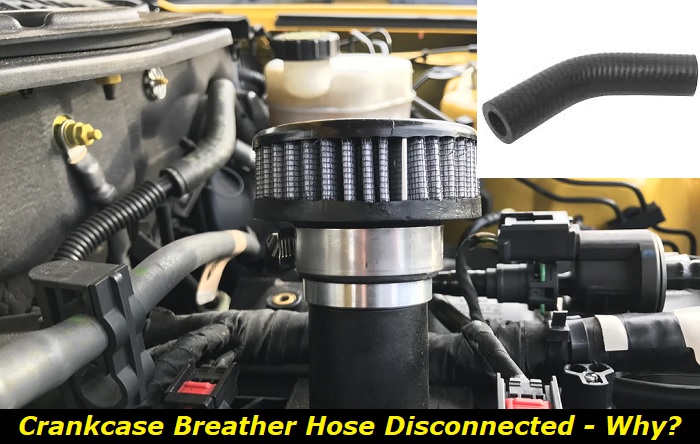Every part of your vehicle matters because they all work in harmony in its delivery of the best performance possible. Once problems start manifesting in them, especially when it concerns the engine, you must do your best to have them addressed without much delay.
Internal engine problems highlights
- Level of importance:High
- Commonreasons:Mileage, poor maintenance, improper use, physical damage
- DIY inspection:Possible but may be complicated
- DIY repair:Possible, in some cases
- Price for repair:$250 - $1,500
- Can you drive?Depends on the issue
- Ways to fix:Locate the problem, outline possible fixes, replace or repair the worn-out parts

How the Crankcase Breather Hose Works in a Vehicle
The crankcase breather hose is a vital part of an automotive vehicle as it provides an avenue for the release of pressure from within the engine's crankcase. The pressure that builds up inside the crankcase, which is caused by combustion and friction between moving parts, must be released to keep the engine running smoothly and reliably. The breather hose works like a valve in this regard; allowing excess pressure to escape into the atmosphere without contaminating other components of your vehicle.
There are several key advantages to having a properly functioning crankcase breather hose:
1. Improved Engine Performance
When sufficient intake of air reaches the cylinders during each compression cycle, it helps create higher power output, improved fuel economy, smoother idling, and fewer emissions. The crankcase breather hose helps ensure that the air intake is consistent and sufficient to achieve these results.
2. Reduced Wear and Tear
As mentioned previously, pressure must be released from the engine's crankcase for it to function properly. Without this release, more force would be placed on other components which can lead to more wear and tear on your vehicle over time.
3. Lower Maintenance Costs
By keeping other components of your car free from contamination, you can avoid costly repairs and maintenance that may otherwise become necessary due to poor performance or neglecting regular servicing.
4. Less Risk of Damage
Excessive pressure build-up within the crankcase has the potential to cause engine damage, which can be costly to repair. The breather hose helps to prevent this type of damage by allowing the pressure to escape before it reaches a dangerous level.
5. Reducing Oil Consumption
A properly functioning crankcase breather hose will also help reduce oil consumption in your vehicle as it will ensure fewer fumes and particles are released from the engine into the atmosphere.
There are a lot more benefits offered by an effective crankcase breather hose to a vehicle, and these are just some of them. All these advantages make it essential for car owners to understand the importance of this component.
Consequences of a Disconnected Crankcase Breather Hose
A disconnected crankcase breather hose can result in a string of issues in your vehicle if not detected or fixed quickly. Therefore, you must be able to recognize its signs in order for you to avert a potentially serious disaster with your engine and your vehicle in general.
The key indicators usually exhibited by this problem can be one or a combination of the following:
1. Poor Idle
One of the most common effects of a disconnected crankcase breather hose is poor idle. This can be caused by an overpressure in the crankcase, which often occurs when the breather hose is not connected to the engine. When this pressure builds up, it forces air into other parts of the engine, creating imbalances that cause rough idling or even stalling.
2. Oil Leakage
A disconnected crankcase breather hose can also lead to oil leakage from both the area around the valve cover and from inside or near the carburetor intake manifold. As excess pressure accumulates in the crankcase due to lack of ventilation, it pushes oil past gaskets and seals, causing leaks.
3. Low Oil Pressure
With a disconnected crankcase breather hose, the engine may not get enough lubrication from the oil, resulting in low oil pressure. This can cause premature wear on other parts of the engine and lead to decreased performance and efficiency.
4. Hard Starting
The lack of ventilation caused by a disconnected breather hose can also make it difficult for your vehicle to start up and run properly. A hard starting condition is often caused by the accumulation of air in the carburetor due to excessive crankcase pressure, which reduces fuel atomization and flow into the combustion chamber, resulting in a harder time firing up your vehicle.
5. Increased Fuel Consumption
Due to all these other issues, such as hard starting and poor idle, your vehicle may consume more fuel than usual. This added consumption can be avoided by replacing the breather hose and restoring balanced pressure in the crankcase.
6. Blow-by
Blow-by is the process of unburnt fuel and exhaust gases entering the crankcase via piston rings. When a breather hose is disconnected, it can cause an excessive level of blow-by in your engine which can cause increased oil consumption and accelerated wear on internal components. This in turn can lead to decreased performance and efficiency in your vehicle.
7. Excessive Oil Vapor
Disconnected breather hoses also prevent oil vapors from being vented properly, resulting in a buildup of pressure that causes oil vapor to be released into the air intake system of your engine. This results in combustion irregularities that can reduce power output and even lead to black smoke from the exhaust pipe.
8. Contaminated Air Filter
Another issue with a disconnected breather hose is that it can cause oil vapor to accumulate in the air filter, reducing its efficiency and leading to decreased performance. Cleaning or replacing your air filter regularly is the only way to prevent this from happening.
9. Clogged Catalytic Converter
A clogged catalytic converter is another consequence of a disconnected crankcase breather hose. This occurs because oil vapors build up in the exhaust system and eventually end up blocking the flow of exhaust gases through the catalytic converter, leading to decreased engine performance and reduced fuel efficiency.
10. Damage to the Carbon Canister
If your carbon canister becomes damaged due to a disconnected crankcase breather hose, it can cause a buildup of fuel vapors in the crankcase, resulting in an excessively high pressure that damages other components. This high pressure can also result in oil leakage and other engine issues.
11. Increased Levels of Harmful Emissions
Finally, if left unattended, a disconnected crankcase breather hose can also cause increased levels of harmful emissions from your vehicle, which is not only bad for the environment but also illegal in some states. It is important to have any malfunctioning parts replaced or fixed immediately to ensure that you are driving safely and legally.
The consequences of failing to address a disconnected crankcase breather hose can be serious and potentially costly. It is important to always check your vehicle's breather hose for any signs of disconnection or damage before driving it, to avoid such problems. Ignoring this issue could lead to major vehicle repairs or even total breakdowns if left unchecked for too long.
How to Fix a Disconnected Crankcase Breather Hose
The symptoms of a disconnected crankcase breather hose can seem minor at first but they should never be ignored as they will eventually lead to bigger problems down the road. If you think your vehicle is suffering from this issue, have it checked and repaired as soon as possible. This is the best way to ensure that your vehicle will continue running optimally and safely for a long time.
Most of the time, a simple repair such as tightening clamps may be enough to fix a disconnected breather hose, but it is always best to have a certified mechanic diagnose and repair the issue properly. Taking care of this problem immediately will help you avoid more costly repairs down the road and ensure that your vehicle is running smoothly for years to come.
There are a few more ways to fix a disconnected crankcase breather hose depending on the problem that caused it and whether or not it affected the other components of your engine bay. Normally, this can be one or a combination of the following:
1. Replacing the Breather Hose
If your breather hose is damaged or clogged, you will need to replace it with a new one.
2. Replacing the Vapors Canister
The vapors canister should be inspected for any signs of damage and replaced if necessary.
3. Changing the Air filter
Your air filter may have become contaminated due to oil vapors from the disconnected breather hose and require cleaning or replacing.
4. Cleaning or Replacing the Catalytic converter
The catalytic converter may be clogged due to excessive oil vapor and require professional cleaning or replacement.
5. Oil Change
Regular oil changes are essential for proper engine functioning and performance, especially when dealing with a disconnected crankcase breather hose as this is often coupled with inspections to ensure that no build-up of oil has accumulated in the engine.
By following the steps provided here, you will be able to prevent performance issues, excessive oil consumption, and other engine issues caused by a disconnected crankcase breather hose.
Conclusion
To wrap things up, a disconnected crankcase breather hose can be dangerous and lead to major issues with your vehicle. If you suspect that this is the cause of any symptoms your vehicle is exhibiting, you must contact a qualified mechanic immediately and have them inspect and repair your vehicle accordingly.
Taking preventative measures such as regularly checking for signs of disconnection and replacing worn parts will ensure that you are driving safely and efficiently at all times. By addressing this issue promptly, you can save yourself time, money, and possibly even worse consequences down the road.
About the authors
The CarAraC research team is composed of seasoned auto mechanics and automotive industry professionals, including individuals with advanced degrees and certifications in their field. Our team members boast prestigious credentials, reflecting their extensive knowledge and skills. These qualifications include: IMI: Institute of the Motor Industry, ASE-Certified Master Automobile Technicians; Coventry University, Graduate of MA in Automotive Journalism; Politecnico di Torino, Italy, MS Automotive Engineering; Ss. Cyril and Methodius University in Skopje, Mechanical University in Skopje; TOC Automotive College; DHA Suffa University, Department of Mechanical Engineering






Add comment